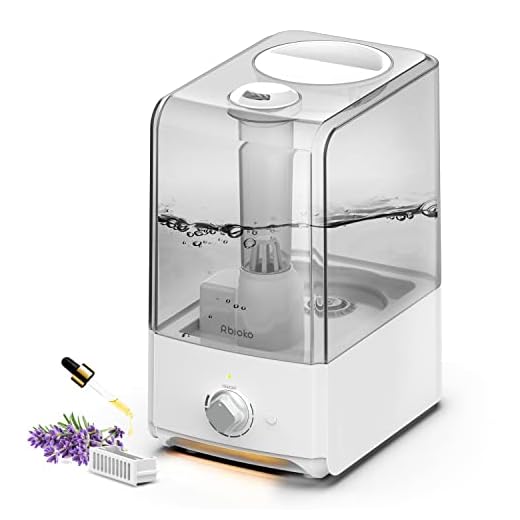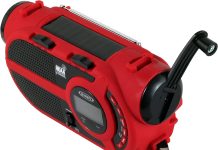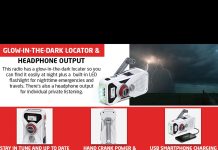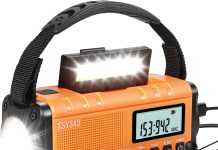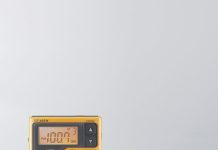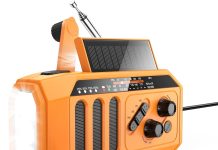Damp air, stale odors, and a sense of disarray. These are the tell-tale signs that mold has taken up residence in your humidifier – an unwelcome guest you must evict immediately!
Cleaning out this pesky intruder is easier than you might think; with four simple steps, you can restore order to your home’s environment. So let us take a closer look at how to clean mold from your humidifier quickly and efficiently.
It may seem daunting, but it doesn’t have to be intimidating! Cith the right supplies and proper precautions. To start on the right foot, gather some rubber gloves, white vinegar, baking soda, and any tools needed for taking apart the tank or reservoir of water. Donning your gloves should come first – safety always comes before any. Cleaning out your humidifier will soon become second nature with the right supplies and proper precautions. Hing else when dealing with household projects?
Now that you’re all set with everything required for removing the grimy buildup caused by mold growth inside your unit, it’s time to get down to business. Follow our easy step-by-step guide below and say goodbye to those damp smells permeating your home!
Review contents
Overview Of Mold Growth In Humidifiers
Mold growth in humidifiers can be a common occurrence, even more so if the device isn’t regularly cleaned. Causes of mold growth include high humidity levels, warm temperatures within the humidifier, and any organic material such as dirt, dust, or other debris that collects on the inside walls due to lack of cleaning.
Mold spores are present in all environments, including your home or office, and will grow when given the right conditions. Knowing how to prevent and remove mold from your humidifier is vital to running it efficiently and safely.
Several signs indicate you may have a problem with mold in your humidifier; these include bad smells coming from the machine, visible mold spots on surfaces around it, difficulty breathing near the machine, or water stains indicating standing water accumulation. If you notice any of these symptoms, taking action immediately before mold spreads further throughout your home or workplace is essential.
Preventing mold growth is simple; a regular cleaning schedule should be implemented where all removable parts are removed and washed using hot soapy water. Be sure to dry each part thoroughly after washing before reassembling them back into the device.
Additionally, keep an eye on humidity levels in your environment – too much moisture can lead to excess condensation inside the unit and increase the chances of mold developing over time.
Identifying And Evaluating The Extent Of Mold Infestation
Once the mold in your humidifier has been determined, it’s essential to identify and evaluate the extent of the infestation. To do this, first inspect all components of your humidifier for signs of mold growth, including any filters or pads that may be present. This will help you determine how best to address the issue.
Visible mold should be identified by color; black and green are standard colors associated with dangerous molds. Additionally, use a flashlight to look into areas with hidden mold growth.
Next, assess the severity of the infestation based on what you see. Consider factors like how much area is affected and whether there appears to be significant discoloration due to staining caused by long-term exposure to moisture.
If possible, try to identify if more than one type of mold is present and which species they belong to. Finally, consider whether spores from the contaminated humidifier have affected any other parts of your home.
By correctly identifying and evaluating the extent of a mold infestation in a humidifier, homeowners can decide how best to proceed with remediation efforts and take steps toward restoring their indoor air quality to safe levels.
Preparing To Clean Out The Mold
Before cleaning out mildew from your humidifier, gathering a few essential items is crucial. First, you’ll need a cleaning solution specifically designed for mold removal. This can be found at most hardware and home improvement stores.
Next, you should disassemble the humidifier according to the manufacturer’s instructions. Make sure not to lose any of the pieces during this step! Finally, have some paper towels or rags to remove each part as necessary during reassembly. The importance of adequately preparing before cleaning cannot be overstated; having everything ready before starting will make things much more manageable.
Disassembling And Cleaning The Humidifier Parts
Disassembling your humidifier is the first step in cleaning it out. To do this, unplug the unit and remove all its removable parts, such as the filter, tank cover, and other detachable components. Place these pieces on a flat surface that won’t be damaged by water or cleaner. If you’re unsure how to disassemble your humidifier, consult your user manual for instructions.
Once all the parts are removed from the humidifier, you can begin cleaning them one at a time using warm soapy water and a soft cloth. Use a non-abrasive cleaner or white vinegar solution before scrubbing with an old toothbrush or tool for tougher stains and spots. Rinse each part thoroughly after cleaning it to remove any remaining soap residue or debris. You can also give each piece a final wipe-down with rubbing alcohol if desired.
When finished with the cleaning process, dry off all the pieces carefully with a clean microfiber cloth or paper towel and reassemble them back onto the base of your humidifier. Connect everything securely according to manufacturer instructions and then plug in the appliance again when ready to start using it again.
Choosing A Cleaning Solution
Now that the humidifier has been disassembled and all parts have been cleaned, it is time to choose a cleaning solution. Selecting the best cleaner solution can be daunting, but there are a few key factors to remember.
It’s essential to research what material your humidifier consists of before selecting an optimal cleaning solution. The first factor to consider when choosing a cleaning solution is whether or not it will harm any of the materials used in the humidifier. Some cleaners contain chemicals that could corrode metal or plastic parts within the device, so finding out what type of cleaning agent works best for your specific model is essential.
Secondly, pick a cleaner that is specifically designed for use on household appliances like humidifiers. These products often have instructions indicating how long to leave them on certain surfaces before wiping them clean. Furthermore, these cleaners usually include ingredients like vinegar and baking soda, which are more gentle than harsher chemical-based solutions, making them safer and better for general appliance maintenance.
Lastly, avoid using abrasive sponges or scrub brushes as they may scratch delicate surfaces inside the humidifier, such as glass or ceramic components. Instead, opt for soft cloths that won’t damage any part of the machine while still providing excellent results without leaving behind streaks or residue from more vital substances such as bleach or ammonia-based cleaners. With careful consideration of these guidelines, you’ll be able to find just the right product for keeping your device running smoothly and looking its best!
Steps For Cleaning Out The Mold
The first step in cleaning mold out of your humidifier is disassembling it. This means taking apart the parts of your humidifier, such as the base and filter. Ensure you have all the pieces laid out separately to be cleaned individually.
Next, mix a solution of one-part vinegar and two parts water. Use this mixture to thoroughly clean each humidifier piece with a soft cloth or brush. Once finished, rinse the pieces off with warm water until no more residue remains from the solution. Be sure to get into any hard-to-reach places where mold may be hiding.
Finally, reassemble your humidifier according to its instructions and run it for 10 minutes before testing it out by adding some drops of water onto the outside surface near an air intake vent. If you see condensation form on the outside surface within 15 seconds, you know your humidifier is working correctly again!
Reassembling And Testing The Humidifier
The dawn of a new day brings the promise of freshness and renewal. This feeling can be replicated when reassembling an old humidifier, especially after thoroughly cleaning all the mold from within.
Reassembling a clean humidifier is like taking flight into a sky free from clouds – you know things will only get better from here.
To successfully reassemble the humidifier, one must consult the instructions manual for detailed instructions on correctly putting everything back together. Each piece must be in its rightful place because any mistake could compromise functioning or, worse, result in injury. Once complete, one should check that all components are securely fastened and then plug it into an electrical outlet to ensure electricity reaches it safely and effectively.
Finally, once plugged in, test whether the humidifier works by running through various functions according to manufacturer specifications. If all checks out without issue, congratulations! The hard work has paid off; now you have a clean and functional humidifier at home.
Maintaining A Humidity Level To Prevent Future Mold Growth
Maintaining the correct humidity level in your home is critical to preventing mold from growing in your humidifier. To keep optimal humidity levels, you should purchase a hygrometer and adjust it according to the manufacturer’s instructions for the type of humidifier you have.
This regularly maintained device will accurately measure and display the relative humidity inside your home so that you can make sure it doesn’t get too high or too low. You should also do regular maintenance on your humidifier, such as changing filters and cleaning out tanks, to remove all dirt and debris before they start causing problems with maintaining healthy air quality.
Additionally, consider investing in an automatic shut-off feature that will turn off the unit once the desired moisture level has been reached. This way, you won’t overload your system with too much water and encourage mold growth. These preventive steps can help protect against future issues caused by excess moisture buildup due to neglecting proper humidifier maintenance and control.
Utilizing Air Purifiers To Remove Excess Moisture From The Room
Air purifiers are a great way to reduce excess moisture in the room and maintain healthy humidity levels. They draw air into their system, using various purification methods to remove particles, including dust, pollen, pet dander, and other airborne pollutants. Removing these contaminants from the air can also help improve overall indoor air quality.
The type of air purifier you choose will depend on your specific needs and preferences. Some models use activated charcoal filters that absorb odors and harmful gases, while others employ ultraviolet light technology to kill bacteria and other microorganisms in the air. There are even some units that combine both techniques for maximum efficiency.
No matter which kind you select, it is important to regularly replace or clean the filters as needed to ensure optimal performance. Doing so will not only extend the life of your unit but also keep your home free from excessive moisture caused by mold growth, allergens, and other irritants.
Considerations For Different Types Of Humidifiers
As we journey into the humidifier domain, we must pause momentarily and consider all our options. While air purifiers help to protect us from excess moisture in the room, selecting an appropriate type of humidifier is critical to attaining optimal humidity levels. With this in mind, consider some essential considerations when choosing a humidifier.
First and foremost, the size of your room should be considered. If you have a large area needing coverage, opting for a larger unit with higher water capacity will ensure better results. Desktop-style models may suffice nicely for smaller rooms or areas with limited space.
In addition to the size of your space, determining the proper humidity level is vital; too much can create uncomfortable conditions, while too little won’t provide enough benefit. Knowing what range works best for your home environment is crucial, as different types of units offer varying degrees of performance in outputting moisture into the atmosphere.
Finally, make sure to factor in other elements, such as whether there is an integrated filtration system and how e, effective it is at improving air quality by trapping particles like dust mites and pollen spores out of circulation.
This is highly beneficial, especially if anyone in your residence suffers from allergies or asthma-related issues, since clean air can make their lives easier and more comfortable overall. To sum up, assessing room size, desired humidity levels, and extra features before purchasing any humidifier will guarantee satisfaction no matter which types you select!
Benefits Of Regularly Cleaning Your Humidifier
Regularly cleaning your humidifier is essential for improving the air quality in your home and preventing mold growth. Humidifiers are great for adding moisture to the air, but if not correctly cared for, they can be a breeding ground for bacteria and fungi such as mold spores. Regular cleaning of your humidifier ensures it runs efficiently and effectively while providing numerous health benefits.
One of the main advantages of regularly cleaning your humidifier is improved air quality. A dirty humidifier can release allergens into the air, which can cause various respiratory issues, including asthma or bronchitis. Furthermore, dust mites and other microscopic organisms may accumulate inside a dirty unit leading to unhealthy indoor environments. Cleaning out your humidifier regularly will reduce these risks by eliminating any germs or debris that built up over time.
Another benefit of regularly cleaning your humidifier is the prevention of mold growth. Mold thrives on warm, damp surfaces like those found in most residential homes with high humidity levels, making them ideal candidates for growth within a neglected unit. If this occurs, it could lead to serious health problems due to the inhalation of mold particles in the air – something nobody wants! A thorough cleaning every couple of weeks helps eliminate any potential sources of fungal contamination.
It’s important to remember that maintaining a clean humidifier isn’t just about keeping it running smoothly – it’s also about protecting yourself and others from breathing in harmful contaminants. With just a few minutes spent each month doing basic maintenance tasks, you can ensure that everyone in the family stays safe and healthy all year.
Ways To Monitor Air Quality In Your Home
It is a fact that the air quality inside our homes can be worse than outside. This is especially true if you have pets, smoke, or live in an area with poor outdoor air quality. The good news is there are plenty of ways to monitor and improve your home’s air quality.
One way to do this is using an air quality monitor like those used for indoor pollution monitoring. These devices measure levels of pollutants such as carbon dioxide, methane, volatile organic compounds (VOCs), and other harmful gases. By knowing how much of these contaminants are present in your home, you’ll know what areas need attention first when it comes to improving the air quality in your home.
Another way to monitor your home’s air quality is by checking its humidity levels. High humidity indoors can lead to mold growth, affecting indoor air quality significantly. Fortunately, most humidifiers have sensors that allow you to check the current humidity level and adjust accordingly. Additionally, standalone monitors are available on the market, allowing you to track changes in relative humidity over time to spot any potential issues before they worsen.
Finally, an air purifier is another excellent tool for improving indoor air quality. Air purifiers use filters or electrostatic technology to capture particles from the air, such as dust mites, pollen, pet dander, and more, making them excellent tools for reducing airborne allergens and increasing indoor comfort levels, also helping reduce odors caused by cigarette smoke or cooking fumes. While some models require regular filter replacements, others offer permanent filtration solutions which last up to five years without needing replacement parts – making them cost-effective options for long-term use too!
Environmental Concerns Related To Humidifiers
Using a humidifier can have both positive and negative environmental impacts. The moisture levels in the air can be regulated to address issues such as dry skin, but they could also lead to an increase in mold growth if not used correctly. To ensure your home or office is safe from potential health risks associated with humidity, it’s essential to understand how using a humidifier affects the environment.
Humidifiers can add moisture to a room without having any significant long-term effects on the environment. However, specific considerations need to be taken into account when using them. For example, too much moisture can create ideal conditions for mold growth, resulting in poor air quality and spreading allergens throughout a space. This is why regular cleaning and maintenance of your humidifier is essential for preventing mold or bacteria buildup over time.
Another environmental concern related to humidifiers involves the energy efficiency of these devices. To properly regulate moisture levels in your home, you’ll likely have to use more energy than usual due to the amount of water needed to operate a humidifier efficiently. With this said, investing in energy-efficient models is wise to save money while maintaining healthy moisture levels indoors.
Health Implications Of Inhaling Mold Spores
Ah, the joys of humidifiers. Not only do they keep your home comfortable and the air moist, but now we can add “cleaning mold” to our list of additional duties! Little did we know that those tiny spores could cause such a stir concerning health implications.
Taking proper precautions when inhaling mold spores from a humidifier is essential. Many people are unaware of how easily mold can accumulate inside their humidifiers due to improper maintenance or failure to clean regularly. If left untreated, it can lead to respiratory problems and allergic reactions in some individuals. This is why it’s essential to establish an effective cleaning routine for your humidifier regularly.
Fortunately, there are steps you can take right away if you find yourself dealing with a musty-smelling machine: First, make sure that the water tank has been emptied before beginning any cleaning process; second, use either white vinegar or hydrogen peroxide as a solution to scrub down all surfaces within the unit; third, rinse thoroughly using hot tap water (or distilled water) until no residue remains; lastly, allow ample time for drying before reassembling and refilling with fresh water. By following these simple steps every few weeks at minimum, you should be able to effectively reduce any potential threat posed by inhaling mold spores from your humidifier.
To ensure optimal safety levels regarding indoor air quality, perform periodic checks on your appliance’s interior components and exterior design – this will help minimize the risk of airborne contaminants entering the living space around you.
Professional Solutions For Removing Mold From Your Humidifier
If you’ve tried the DIY steps and still cannot get all the molds out of your humidifier, it may be time to seek professional help. Several companies specialize in removing mold from water-based appliances like humidifiers. These experts have access to advanced cleaning products that can eliminate even stubborn mold buildups. They also possess special tools for getting into small crevices where mold might hide.
In addition to these specialized services, some companies offer full-scale mold remediation services. This involves identifying potential sources of moisture or other problems that could lead to future mold growth. The professionals will then advise on preventing further outbreaks and educate you about proper home maintenance practices for humidity devices.
Finally, if you want peace of mind knowing that your household is free from harmful molds, consider having regular inspections done by an experienced company with certified technicians who know what they’re doing. With their expertise, you can know that your family is safe from unwanted airborne contaminants such as mold spores.
Frequently Asked Questions
What Is The Best Way To Prevent Mold Growth In A Humidifier?
The adage, “An ounce of prevention is worth a pound of cure,” could not be more relevant when considering the best way to prevent mold growth in a humidifier. Taking the proper steps to avoid mold growth and minimize the buildup of spores can help keep your home from becoming overrun with contamination. Consider several best practices to ensure you take all necessary precautions to prevent mold growth in a humidifier.
First, regularly clean and replace components such as filters, tanks, wicks, and water reservoirs. It is essential to check these system parts frequently for signs of wear or mildew; if any are found, they must be replaced immediately. Additionally, using distilled water instead of tap water will reduce mineral deposits which can lead to increased chances of forming mold on surfaces within the unit. Lastly, keeping humidity levels low by setting automatic shut-off features at recommended settings has been shown to reduce the chance of excessive moisture leading to mold formation inside the device itself.
When avoiding mold growth in a humidifier, following these simple tips can ensure your home remains free from contaminants. Keeping up with regular maintenance tasks like cleaning out filters and replacing them often, and utilizing distilled water helps significantly lower risk factors associated with mold buildup. Setting appropriate humidity levels also plays an essential role in minimizing potential outbreaks while still providing optimal comfort throughout your living space.
Is It Safe To Use Bleach To Clean Mold Out Of A Humidifier?
Using bleach to clean mold out of a humidifier is an important question, especially with the potential health risks associated with mold growth. Bleach can be an effective cleaning agent, but it’s also possible that using it could cause more problems than solutions. So, is it safe to use bleach to clean mold out of a humidifier?
The answer isn’t simple and depends on your humidifier type and what kind of mold you’re dealing with. If you have a cold mist or ultrasonic humidifier, and your mold problem is relatively mild, it may be safe to use bleach. However, if your humidifier has any other type of filter system (like an ionic or warm mist), then using bleach could potentially corrode the parts inside, making matters worse in the long run.
When deciding whether or not to use bleach for cleaning mold from your humidifier, consider all relevant factors, such as safety precautions and how much damage this might do compared to just replacing worn-out components. It’s always best to consult the manufacturer’s instructions before using chemical cleaning agents like bleach when dealing with mold in a humidifier. Additionally, make sure that whatever product you choose won’t damage the materials used in the construction of your unit.
How Often Should A Humidifier Be Cleaned To Prevent Mold Growth?
Maintaining a clean and healthy humidifier is essential for preventing mold growth. Knowing how often to clean your humidifier can help ensure that it doesn’t become susceptible to an accumulation of mold or mildew. The current H2, ‘How often should a humidifier be cleaned to prevent mold growth?’ provides essential insight into the frequency at which one should take action to keep their device functioning correctly.
Humidifiers must be regularly cleaned if you want to avoid potential problems related to mold growth and contamination. Experts recommend cleaning out your humidifier at least once every two weeks, although some may suggest more frequent intervals depending on usage levels. This process involves emptying any water stored within your machine and wiping all internal surfaces with vinegar or other chemical-free solutions. Additionally, most manufacturers provide detailed instructions on maintaining their specific models.
Ensuring your humidifier is free from mold and bacteria requires regular maintenance and attention–especially during periods of heavy use. Cleaning your device frequently will help extend its life span and improve air quality by ensuring that no harmful particles are being spread into the atmosphere through the mist produced by your appliance. Taking proactive steps like these can go a long way toward keeping you safe from airborne contaminants while maintaining healthier indoor humidity levels throughout the year.
By adhering to proper guidelines for humidifier cleaning frequency and preventive measures like using natural cleaners or disinfectants, you’ll be able to effectively reduce the chances of developing any issues associated with mold growth and bacterial contamination of your device. With simple steps and regular upkeep, you can ensure your environment remains safe and healthy without worrying about pesky allergens or unpleasant odors caused by moisture buildup within the room’s air supply system.
Are There Any Health Risks Associated With Inhaling Mold Spores?
Mold is an airborne contaminant that thrives in moist environments such as humidifiers, making it especially important to clean them regularly to prevent growth.
Mold spores can be dangerous when inhaled, and the health risks associated with mold inhalation must be considered. But what are the potential health risks of inhaling these spores?
When a person breathes in mold spores, they can cause allergic reactions or even lead to more serious respiratory problems. The severity of symptoms depends on the individual’s exposure and the type of inhaled spore.
People with allergies or asthma may experience more severe reactions than those without medical conditions due to their heightened sensitivity. In addition, people with compromised immune systems, such as HIV/AIDS patients, may also be at greater risk for developing infections from breathing in mold spores.
It’s essential to take precautions when cleaning your humidifier so you don’t accidentally expose yourself to lingering mold spores.
It’s best to wear protective gear like gloves and masks while handling potentially contaminated materials and use cleaning products specifically formulated for removing mold effectively and safely. Taking preventive steps now will help minimize your risk of inhaling harmful spores later on down the line.
What Type Of Humidifier Is Best For Preventing Mold Growth?
Have you ever wondered what type of humidifier prevents mold growth? The answer to this question depends on several factors, including the type of humidifier and how it is maintained.
By understanding different types of humidifiers and their associated maintenance requirements, you can decide which one will most effectively prevent mold growth in your home.
When selecting a humidifier, there are three main types: evaporative, ultrasonic, and impeller models. Evaporative humidifiers use filters that require regular replacement to prevent bacteria buildup; thus, they require more frequent maintenance than other types. Ultrasonic units use high-frequency sound waves to produce mist but also need cleaning since algae can form over time due to water standing in the unit.
Impeller models utilize rotating disks that create a fine mist without water accumulation; however, these must still be cleaned regularly with vinegar or bleach solutions as dust accumulates quickly.
In addition to choosing the right type of humidifier, proper maintenance is critical for keeping mold out of your home environment. Regularly changing the filter or disc when necessary helps reduce bacterial growth and should always be done according to manufacturer instructions.
It’s also important not to forget basic cleanliness practices like wiping down surfaces after each use and periodically emptying any accumulated moisture from the device. Both tasks help keep mold away too!
By considering all aspects involved in purchasing and maintaining a suitable humidifier for your space – such as type, model parts replacements, and general cleanliness – you can find the ideal option for helping keep mold out of your home breathing air!
Conclusion
In conclusion, mold growth in a humidifier can lead to many health risks. While taking steps to prevent mold growth is essential, it may be difficult to avoid sometimes. Therefore, knowing how to clean and maintain your humidifier effectively is essential.
Choosing the correct type of humidifier for your needs; some types are better suited for preventing mold than others.
Always read the instructions carefully when cleaning a humidifier with bleach or other cleaning agents, and wear protective gear. Cleaning should be done regularly – at least once every two weeks – and any signs of visible mold must immediately be addressed.
Finally, one interesting statistic shows that up to 1 million people worldwide die from respiratory illnesses caused by inhaling airborne fungi each year.*
This emphasizes the importance of ensuring our home environments are free from these dangerous spores. So if you’re using a humidifier, check for any signs of mold and make sure you clean properly!
*WHO Report: The Burden of Disease from Indoor Air Pollution
LEVOIT Humidifiers for Bedroom Large Room, 3L Cool Mist Top Fill Oil Diffuser for Baby Nursery and Plants, 360° Nozzle, Quiet Rapid Ultrasonic Humidification for Home Whole House, White
AquaOasis™ Cool Mist Humidifier (2.2L Water Tank) Quiet Ultrasonic Humidifiers for Bedroom & Large room - Adjustable -360 Rotation Nozzle, Auto-Shut Off, Humidifiers for Babies Nursery & Whole House
$29.96 in stock
2 used from $26.96
Cool Mist Humidifiers for Bedroom - 2.2L Water Tank, Baby, Office, Quiet Ultrasonic Air Vaporizer, Adjustable Mist Level, 360 Nozzle Rotation, Auto-Shut Off, Large Area Humidifier Easy Fill and Clean
$18.99 in stock
4 used from $14.44
Humidifiers for Bedroom, raydrop Cool Mist Humidifiers for Babies, 1.70L Quiet Ultrasonic Humidifier, Space-Saving, Filterless, Auto Shut Off - (0.45 Gallon, US 110V)
$25.99 in stock
LEVOIT Dual200S Smart Cool Mist Humidifiers for Bedroom, Top Fill Diffuser for Baby Nursery, Air Humidifiers with Humidistat, Ultrasonic, 3L, White
LEVOIT Humidifiers for Bedroom Large Room Home, 6L Cool Mist Top Fill Essential Oil Diffuser for Baby and Plants, Smart App & Voice Control, Rapid Humidification and Humidity Setting, Quiet Sleep Mode
Top Fill Humidifier with Essential Oil Diffuser 4L for Home, Baby, Bedroom, Large Room & Indoor Plants, Cool Mist Ultrasonic Quiet Air Humidifiers, Automatic Humidity Control, Night Light (Black)
$54.97 in stock
Rbioko Humidifiers for Large Room Bedroom (6.5L), Cool Mist Ultrasonic Air Vaporizer for Home Whole House Babies, Customized Humidity, Night Light, Whisper-Quiet (White)
$36.99 in stock

















